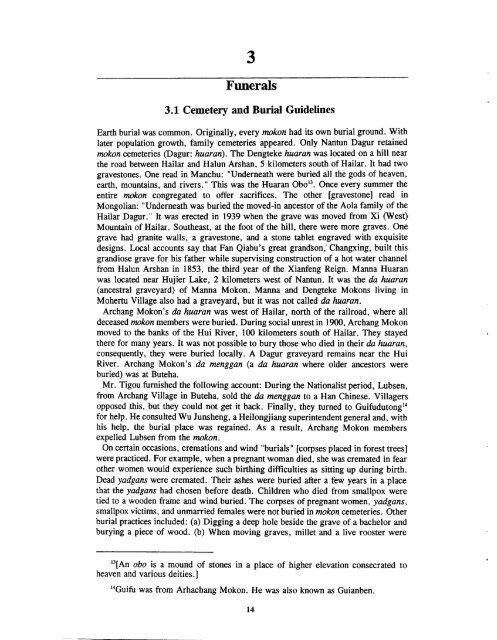China's Dagur Minority - Sino-Platonic Papers
China's Dagur Minority - Sino-Platonic Papers
China's Dagur Minority - Sino-Platonic Papers
Create successful ePaper yourself
Turn your PDF publications into a flip-book with our unique Google optimized e-Paper software.
Funerals3.1 Cemetery and Burial GuidelinesEarth burial was common. Originally, every mokon had its own burial ground. Withlater population growth, family cemeteries appeared. Only Nantun <strong>Dagur</strong> retainedmokon cemeteries (<strong>Dagur</strong>: huaran). The Dengteke huaran was located on a hill nearthe road between Hailar and Halun Arshan, 5 kilometers south of Hailar. It had twogravestones. One read in Manchu: "Underneath were buried all the gods of heaven,earth, mountains, and rivers." This was the Huaran 0bo13. Once every summer theentire mokon congregated to offer sacrifices. The other [gravestone] read inMongolian: "Underneath was buried the moved-in ancestor of the Aola family of theHailar <strong>Dagur</strong>." It was erected in 1939 when the grave was moved from Xi (West)Mountain of Hailar. Southeast, at the foot of the hill, there were more graves. Onegrave had granite walls, a gravestone, and a stone tablet engraved with exquisitedesigns. Local accounts say that Fan Qiabu's great grandSon,' Changxing, built thisgrandiose grave for his father while supervising construction of a hot water channelfrom Halun Arshan in 1853, the third year of the Xianfeng Reign. Manna Huaranwas located near Hujier Lake, 2 kilometers west of Nantun. It was the da huaran(ancestral graveyard) of Manna Mokon. Manna and Dengteke Mokons living inMohertu Village also had a graveyard, but it was not called diz haran.Archang Mokon's da huaran was west of Hailar, north of the railroad, where alldeceased mokon members were buried. During social unrest in 1900, Archang Mokonmoved to the banks of the Hui River, 100 kilometers south of Hailar. They stayedthere for many years. 1t was not possible to bury those who died in their da huaran,consequently, they were buried locally. A <strong>Dagur</strong> graveyard remains near the HuiRiver. Archang Mokon's da menggan (a da huaran where older ancestors wereburied) was at Buteha.Mr. Tigou furnished the following account: During the Nationalist period, Lubsen,from Archang Village in Buteha, sold the da menggan to a Han Chinese. Villagersopposed this, but they could not get it back. Finally, they turned to Guifudutong14for help. He consulted Wu Junsheng, a Heilongjiang superintendent general and, withhis help, the burial place was regained. As a result, Archang Mokon membersexpelled Lubsen from the mokon.On certain occasions, cremations and wind "burials" [corpses placed in forest trees]were practiced. For example, when a pregnant woman died, she was cremated in fearother women would experience such birthing difficulties as sitting up during birth.Dead yadgans were cremated. Their ashes were buried after a few years in a placethat the yadgans had chosen before death. Children who died from smallpox weretied to a wooden frame and wind buried. The corpses of pregnant women, yadgans,smallpox victims, and unmarried females were not buried in mokon cemeteries. Otherburial practices included: (a) Digging a deep hole beside the grave of a bachelor andburying a piece of wood. (b) When moving graves, millet and a live rooster were''[An obo is a mound of stones in a place of higher elevation consecrated toheaven and various deities .]''Guifu was from Arhachang Mokon. He was also known as Guianben.
















